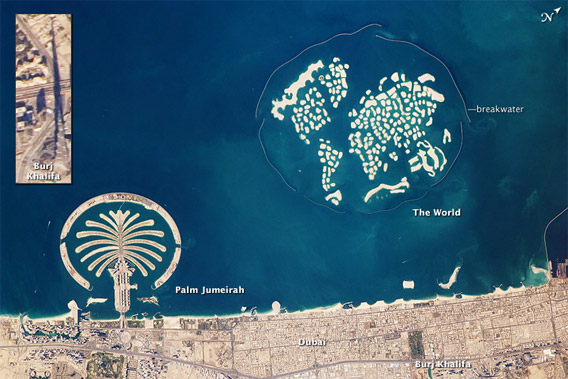NASA has released an updated satellite photo showing Dubai’s artificial islands and its newly completed Burj Khalifa, the world’s tallest building which stands more than 800 meters (2600 feet tall).
The projects, which were much hyped during development, are seeming ill-conceived on the heels of Dubai’s real estate market crash and two bailouts by Abu Dhabi, Dubai’s oil-rich neighbor.
The island projects — including the two Palm Islands (Palm Jumeirah and Palm Jebel Ali), which appear as stylized palm trees when viewed from above, and the 300 islands that make up “The World” — were controversial for their impact on the surrounding marine environment. Construction the The World islands required some 320 million cubic meters of sand and 37 million tonnes of rock for the surrounding 27-kilometer-long protective breakwater, while the Palm Jumeirah required more than 50 million cubic meters of sand dredged from the sea floor.
The NASA photo, taken January 13, 2010, shows little infrastructure development on islands of The World (started in 2003 and completed in 2008) but extensive construction on Palm Jumeirah (started in 2001 and completed in 2006).

Astronaut photograph ISS022-E-24940 was acquired on c with a Nikon D2Xs digital camera fitted with a 400 mm lens, and is provided by the ISS Crew Earth Observations experiment and Image Science & Analysis Laboratory, Johnson Space Center. The image was taken by the Expedition 22 crew. CLICK IMAGE TO ENLARGE
Related article
Dubai’s artificial islands have high environmental cost August 23, 2005
In addition to its penchant for acquiring records for the Guinness Book of World Records, Dubai has lately embarked on an ambitious plan to boost its international standing in the eyes of the world’s rich (and its neighbors) by building a number of artificial islands. These islands, which will house luxury residences, villas, and hotels, are a growing concern for environmentalists due to their impact on the local marine ecology. Dubai should be concerned as well for the long-term viability of the plan — rising sea levels from global climate change could spell trouble for its audacious and ostentatious investments. As Earth Island Journal puts it, “How ironic that the very people who drive rising sea levels through their businesses, which emit much of the world’s greenhouse gases, will undoubtedly be some of the first to experience the devastating effects of climate change.”